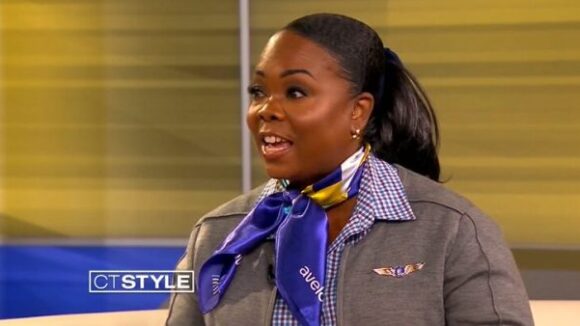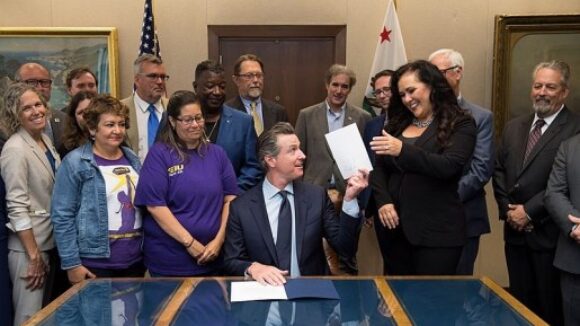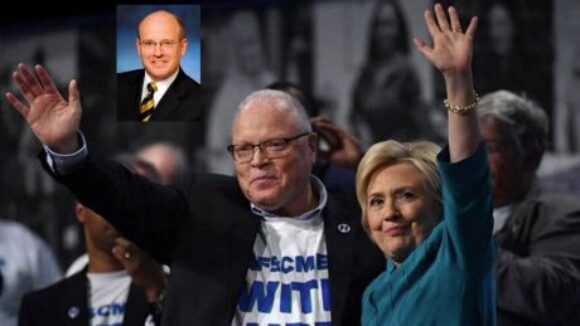‘People Have a Right to Make Their Own Choice’
Avelo employee Kim Howard believes all the firm’s flight attendants should get to vote on continued AFA rule. Credit: WTNH-TV (ABC,…

Drawing on a variety of published sources, the National Institute for Labor Relations Research has recently estimated that Big Labor spent more than $1.7 billion on politics and lobbying in 2015 and 2016.
The Institute fact sheet analyzing union bigwigs’ expenditures intended “to influence the selection, nomination, election, or appointment of anyone” to “public office” and for other political/ideological purposes over the past two years was published on April 17.
(To access a copy, go to: http://www.nilrr.org/wp-content/uploads/facts/2016-election-cycle-union-fact-sheet-web.pdf on the Internet.)
The Institute’s analysis relies almost entirely on reporting forms filed by union officials themselves with federal and state government agencies.
Poor-mouthing union officials and supposedly “nonpartisan” monitors like the Center for Responsive Politics have long fostered the totally false impression that Big Labor PAC and Section 527 expenditures represent all the electioneering unions do.

Forced-Dues-Stocked Union Treasuries Finance Get-Out-the-Vote Activities
But the LM-2 forms that private-sector and some government-sector unions with annual revenues exceeding $250,000 are required to file with the U.S. Labor Department, along with other publicly available resources, show they actually control by far the most massive political machine in America.
In 2003, then-President George W. Bush’s Labor Department revised LM-2 forms with the avowed goal of helping millions of private-sector workers who are forced to pay union dues or fees as a job condition get a better idea of where their conscripted money is going.
This was a worthwhile initiative.
Current labor laws, as interpreted by federal courts, authorize the firing of employees for refusal to pay for unwanted monopoly bargaining, unless the employees are protected by a Right to Work law. But the U.S. Supreme Court, in precedents argued and won by National Right to Work Legal Defense Foundation attorneys, has established that employees may not legally be terminated for refusal to pay for Big Labor’s non-bargaining activities — regardless of where they live.
Unfortunately, in a misguided and futile attempt to appease the union brass, Bush officials failed to require union reports to segregate strictly all bargaining and non-bargaining activities in the revised LM-2’s.
Nevertheless, since the LM-2 revision withstood an extended Big Labor court challenge and took effect over a decade ago, union officials have been required to report each year how much they spend on two major non-bargaining activities – electioneering and lobbying.
The Institute review of all LM-2 forms filed for 2015 and 2016 shows that unions filing such forms spent a total of nearly $1.3 billion on “political activities and lobbying” over those two years alone.
Such forced-dues-fueled spending pays for phone banks, get-out-the-vote drives, propaganda mailings, and other so-called “in-kind support” for candidates.
As a front-page Wall Street Journal article by Tom McGinty and Brody Mullins published in July 2012 explained, a large share of Big Labor’s forced dues-funded political war chest is spent “paying teams of political hands to contact members [and their families].”
Many Deeply Political Unions Don’t Have To File LM-2’s
The political hands’ job is browbeating all the voters in union households into agreement with union official positions on election issues and “trying to make sure they vote for union-endorsed candidates.”
Though the Journal article didn’t mention it, a second important function of forced dues-bankrolled union political operatives is to push up turnout in neighborhoods where Big Labor calculates a very high share of voters will cast their ballots for union-endorsed candidates.
Big Labor political and lobbying expenditures reported on LM-2 forms are the single largest component of the union electioneering machine. But there is plenty LM-2’s don’t cover.
“Government unions that have no private-sector members, including many affiliates of the National Education Association teacher union and other deeply political state and local unions, don’t have to file LM-2’s,” noted Mark Mix, president of both the Foundation and the National Right to Work Committee.
“The Institute analysis added up political spending by such government unions appearing in state campaign finance reports and came up with 2015-16 expenditures totalling roughly $228 million. Union PAC and ‘527 group’ expenditures not reported elsewhere add another $193 million to the 2015-16 war chest.”
Federal Lawmakers Have An Obligation to Act
Unlike business and other interest-group political spending, Big Labor’s “in-kind” expenditures on politics are financed primarily by forced-dues and forced-fee money, often paid by workers who aren’t union members and who personally oppose the union-boss agenda.
“Compulsory-dues privileges made it possible for Big Labor to spend at least $1.7 billion on electioneering and other ideological schemes over the past two years,” said Mr. Mix. He added that the Institute figure was calculated very conservatively to avoid any possible double-counting and is, for that and other reasons, almost certainly an underestimate.
“Fortunately,” he continued, “in the next election cycle, at least 28 states will have Right to Work laws on the books prohibiting forced union membership, dues and fees.
“Employees in such states are protected from being forced to bankroll Big Labor’s favored causes and candidates.
“But it remains Congress’ obligation to crack down on forced-dues politicking and protect the free speech rights of private-sector employees across the nation.
“And this objective can be accomplished by passage of a national Right to Work law that repeals the handful of provisions in federal labor law under which millions of employees are still being forced to bankroll unions.”
(Source: June 2017 National Right to Work Committee Newsletter)

Avelo employee Kim Howard believes all the firm’s flight attendants should get to vote on continued AFA rule. Credit: WTNH-TV (ABC,…

California’s Big Labor-concocted A.B.5, signed into law by Gov. Gavin Newsom in 2019, made it almost impossible for workers and firms to bounce back after 2020’s COVID-19 lockdowns. Now Biden bureaucrats want to federalize A.B.5!

Mr. Fain undoubtedly knows full well that there is a complete disconnect between the UAW hierarchy and the UAW rank-and-file on the Biden presidency and whether workers will benefit from its extension for another four years.